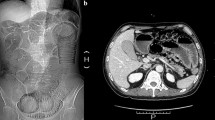Abstract
Objective
To evaluate retrospectively in patients with Crohn’s disease (CD) if magnetic resonance (MR) motility alterations correlate with CD typical lesions leading to an increased detection rate.
Methods
Forty patients with histologically proven CD underwent MR enterography (MRE), including coronal cine sequences (cine MRE), in addition to the standard CD MR protocol. Two blinded readings were performed with and without cine MRE. Locations presenting motility alterations on the cine sequences were analysed on standard MRE for CD-related lesions. This was compared with a second reading using the standard clinical MRE protocol alone.
Results
The number of lesions localised by cine MRE and identified on standard MRE compared with standard MRE alone were 35/24 for wall thickening (p = 0.002), 24/20 for stenoses (p = 0.05), 17/11 for wall layering (p = 0.02), 5/3 for mucosal ulcers (p = 0.02) and 21/17 for the comb sign (p = 0.05). Overall, cine MRE detected 35 more CD-specific findings than standard MRE alone (124/89; p = 0.007) and significantly more patients with CD-relevant MR findings (34/28; p = 0.03).
Conclusion
CD lesions seem to be associated with motility changes and this leads to an increased lesion detection rate compared with standard-MRE imaging alone.



Similar content being viewed by others
References
Travis SP, Stange EF, Lemann M et al (2006) European evidence based consensus on the diagnosis and management of Crohn’s disease: current management. Gut 55(Suppl 1):i16–i35
Masselli G, Casciani E, Polettini E, Gualdi G (2008) Comparison of MR enteroclysis with MR enterography and conventional enteroclysis in patients with Crohn’s disease. Eur Radiol 18:438–447
Negaard A, Paulsen V, Sandvik L et al (2007) A prospective randomized comparison between two MRI studies of the small bowel in Crohn’s disease, the oral contrast method and MR enteroclysis. Eur Radiol 17:2294–2301
Gourtsoyiannis NC, Grammatikakis J, Papamastorakis G et al (2006) Imaging of small intestinal Crohn’s disease: comparison between MR enteroclysis and conventional enteroclysis. Eur Radiol 16:1915–1925
Froehlich JM, Patak MA, von Weymarn C, Juli CF, Zollikofer CL, Wentz KU (2005) Small bowel motility assessment with magnetic resonance imaging. J Magn Reson Imaging 21:370–375
Fidler J (2007) MR imaging of the small bowel. Radiol Clin North Am 45:317–331
Antes G, Lissner J (1983) Double-contrast small-bowel examination with barium and methylcellulose. Radiology 148:37–40
Maglinte DD, Lappas JC, Kelvin FM, Rex D, Chernish SM (1987) Small bowel radiography: how, when, and why? Radiology 163:297–305
Sellink JL, Rosenbusch G (1981) [“The ten commandments” for enteroclysis or ten golden rules for proper enteroclysis technique]. Radiologe 21:366–376
Umschaden HW, Szolar D, Gasser J, Umschaden M, Haselbach H (2000) Small-bowel disease: comparison of MR enteroclysis images with conventional enteroclysis and surgical findings. Radiology 215:717–725
Prassopoulos P, Papanikolaou N, Grammatikakis J, Rousomoustakaki M, Maris T, Gourtsoyiannis N (2001) MR enteroclysis imaging of Crohn disease. Radiographics 21(Spec No):S161–S172
Girometti R, Zuiani C, Toso F et al (2008) MRI scoring system including dynamic motility evaluation in assessing the activity of Crohn’s disease of the terminal ileum. Acad Radiol 15:153–164
Kitazume Y, Satoh S, Hosoi H, Noguchi O, Shibuya H (2007) Cine magnetic resonance imaging evaluation of peristalsis of small bowel with longitudinal ulcer in Crohn disease: preliminary results. J Comput Assist Tomogr 31:876–883
Patak MA, von Weymarn C, Froehlich JM (2007) Small bowel MR imaging: 1.5 T versus 3 T. Magn Reson Imaging Clin N Am 15:383–393 vii
Froehlich JM, Daenzer M, von Weymarn C, Erturk SM, Zollikofer CL, Patak MA (2009) Aperistaltic effect of hyoscine N-butylbromide versus glucagon on the small bowel assessed by magnetic resonance imaging. Eur Radiol 19:1387–1393
Patak MA, Froehlich JM, von Weymarn C, Breitenstein S, Zollikofer CL, Wentz KU (2007) Non-invasive measurement of small-bowel motility by MRI after abdominal surgery. Gut 56:1023–1025
Fleiss JL (1981) Statistical methods for rates and proportions. Wiley, New York
Ajaj W, Goyen M, Schneemann H et al (2005) Oral contrast agents for small bowel distension in MRI: influence of the osmolarity for small bowel distension. Eur Radiology 15:1400–1406
Ajaj W, Goehde SC, Schneemann H, Ruehm SG, Debatin JF, Lauenstein TC (2004) Dose optimization of mannitol solution for small bowel distension in MRI. J Magn Reson Imaging 20:648–653
Pettigrew RI, Oshinski JN, Chatzimavroudis G, Dixon WT (1999) MRI techniques for cardiovascular imaging. J Magn Reson Imaging 10:590–601
Camilleri M, Bharucha AE, di Lorenzo C et al (2008) American Neurogastroenterology and Motility Society consensus statement on intraluminal measurement of gastrointestinal and colonic motility in clinical practice. Neurogastroenterol Motil 20:1269–1282
Vermillion DL, Huizinga JD, Riddell RH, Collins SM (1993) Altered small intestinal smooth muscle function in Crohn’s disease. Gastroenterology 104:1692–1699
Siddiki HA, Fidler JL, Fletcher JG et al (2009) Prospective comparison of state-of-the-art MR enterography and CT enterography in small-bowel Crohn’s disease. AJR Am J Roentgenol 193:113–121
Lee SS, Kim AY, Yang SK et al (2009) Crohn disease of the small bowel: comparison of CT enterography, MR enterography, and small-bowel follow-through as diagnostic techniques. Radiology 251:751–761
Author information
Authors and Affiliations
Corresponding author
Rights and permissions
About this article
Cite this article
Froehlich, J.M., Waldherr, C., Stoupis, C. et al. MR motility imaging in Crohn’s disease improves lesion detection compared with standard MR imaging. Eur Radiol 20, 1945–1951 (2010). https://doi.org/10.1007/s00330-010-1759-x
Received:
Revised:
Accepted:
Published:
Issue Date:
DOI: https://doi.org/10.1007/s00330-010-1759-x




